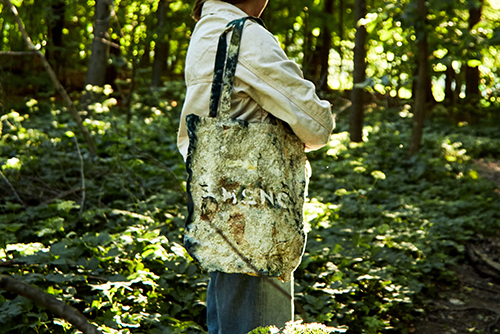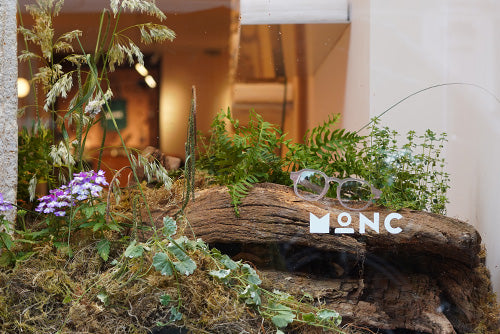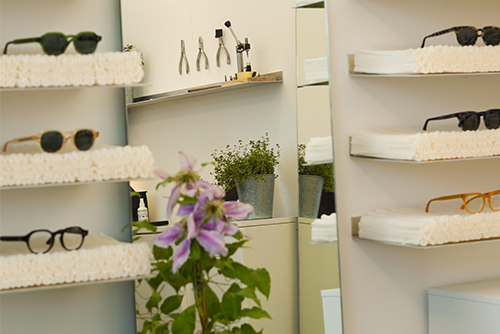MONC brief's Central Saint Martins final year students
The eyewear industry is littered with problems. One of the most poignant is waste. On average 80% of the acetate slab used to create a frame is discarded. In February, we started working with the BA Product and Industrial Design students at Central Saint Martins to rethink some of these issues.
This project culminated at the Central Saint Martin’s degree show, recognised for showcasing some of the most exciting talent in the UK. Artists, designers, industry scouts, friends and parents visit, exploring and celebrating work from the many courses in the show. This year, we were among the visitors of BA Product and Industrial Design, seeing their hard work and the outcomes of our collaborative project.

Our designer Alice, who graduated from the Product and Industrial Design course only two years ago, initiated this partnership back in February. Along with our founder Freddie, she created a brief which asked the students to push the boundaries of our bio-acetate material. This project encouraged potential solutions to the challenges surrounding the production, usage and disposal of bio-acetate. In the 15 weeks since the initial briefing, Alice and Freddie visited the students for feedback sessions, leaving more and more inspired every time.
Last week, Alice and the MONC team got to see the show, and all the impressive work, in person. Visiting the Product and Industrial Design room, it was incredible to see the projects realised in beautiful, high-fidelity models that demonstrated ambitious and innovative thinking.

The ideas ranged from reimagined protective casing to flexible hinges to naturally dyed materials. Drawing heavily on the wasteful process of eyewear production, the students all created work which instigated important conversation and reimagined current industry systems. Congratulations to everyone for such a powerful degree show. We’re certain that each student has a bright future ahead of them. Take a look at some of their projects below.

If you didn't get a chance to visit the degree show, explore the PID student’s project’s below:
Maral Al-Sabah
https://www.instagram.com/p/C8MbinHo0Lz/?img_index=1
Using the lens blanks to turn eyewear waste into eyewear accessories!
Gregoire Pin
https://www.instagram.com/p/C79izFaoL2G/?img_index=4
Transforming waste into luxury Well-being: a facial enhancement kit fully made from recycled materials.
Barimah Asare
https://www.instagram.com/p/C760S0KoVpv/?img_index=6
By using Bio acetate waste converted into 3d printed filament, Soho Glow takes advantage of the unique aesthetic properties of the material and provides a purposeful use for Bio acetate waste, in the form of a lamp.
Lily Wild
https://www.instagram.com/p/C8HhaIFouIc/?img_index=2
Introducing the MONCrest: a sophisticated and eco-friendly eyewear holder designed for MONC, crafted from upcycled bio-acetate waste and off-cuts.
Joseph Moody
https://www.instagram.com/p/C8EeQjYIEp3/?img_index=5
Utilising cellulose acetate’s hypoallergenic, hygroscopic, and water-resistant properties, Aceterre combines chipped acetate waste with recycled polypropylene to create durable, easy-to-clean, and aesthetically versatile sheets.
Charlie Duffy
https://www.instagram.com/p/C7832x4oCdu/?img_index=5
Positioning longevity at the centre of the MONC product experience.
This experience targets MONC customers, especially those less focused on sustainability, to boost their ownership and responsibility toward their eyewear. It includes a repair tool made from waste acetate
Ben Wilson
https://www.instagram.com/p/C8J57T1oJao/?img_index=4
The MONC bio-lights are hung either side of a mirror drawing the customer in and inviting them to try a pair of frames on. The lampshades emit a warm glow through a textured bio-plastic material, that match the theme and temperature of MONC’s flagship store.
Otis Oliver Purchase
https://www.instagram.com/p/C8RxltjIAcV/?img_index=5
A soft quilted sunglasses case made to be impact-proof, inspired by sandbags. The quilting is filled with waste acetate from CNC milling, which creates the most waste within the sunglasses industry.
Qingqing Huang
https://www.instagram.com/p/C8Uc4lOo8C5/?img_index=5
MONC PetUP is an eco-friendly project that recycles and repurposes waste cellulose acetate from eyeglass frame production.
Scarlett Walker-Hebborn
https://www.instagram.com/p/C8UeFQToyJ5/?img_index=5
The MONC note is a collection of acetate notebooks with refillable pages. They allow the user to choose a more sustainable alternative to traditional notebooks
Jack Wood
https://www.instagram.com/p/C8WoPnMoewy/?img_index=5
Bendy eyewear is better! Kerfy hinges generate innovative eyewear that reduce waste in manufacturing and is designed to facilitate sustainable disposal
Quinby Duble
https://www.instagram.com/p/C8Wu6L4oqOr/?img_index=5
This project harnesses the natural malleability of acetate to create a new method of eyewear manufacturing focused on waste reduction.
Oscar O’Reilly
https://www.instagram.com/p/C8Wr-_KIWtB/?img_index=4
M49 Veneer is made from the waste streams of Monc’s frames, using a unique process to create a fully recyclable 100% acetate veneer without any added plasticizers.
Syaleen Stokes
https://www.instagram.com/p/C8Wpdrso_Mk/?img_index=5
Glasses frames manufacturing often results in substantial waste due to traditional methods. Monc innovates by using CNC technology to craft frames from bio-acetate slabs, though this process still produces 70% waste off-cuts. I conducted experiments to transform these off-cuts into durable materials for glasses cases, an accessory that’s often overlooked and underdesigned.
Estair Auhona Robbins
https://www.instagram.com/p/C8e6uT3oMK0/?img_index=5
At the heart of Terra Tinctora lies a transformative concept: unearthing and harnessing the beauty of waste to create vibrant, eco-conscious powdered dyes. These pigments are derived from the waste of cellulose acetate production and agricultural waste sourced from the farms surrounding the MONC workshop and the Mazzucchelli factory.
Tom Crowe
https://www.instagram.com/p/C8aCOI5IkYf/?img_index=5
Colour-Clicks allow a user to simply and securely change the style of their wire frames in order to avoid feeling limited by what they feel they can wear or become.
Zhengxin Li
https://www.instagram.com/p/C8eoegxoeft/?img_index=5
An innovative bio-acetate contact lens case made from leftover frame material, provides a sustainable solution for both spectacle frame and contact lens wearers.
Vuyani Matibiri
https://www.instagram.com/p/C8b3YSmoD3P/
3 peice jewellery collection that offers a sustainable alternative to nigerian coral jewellery.


